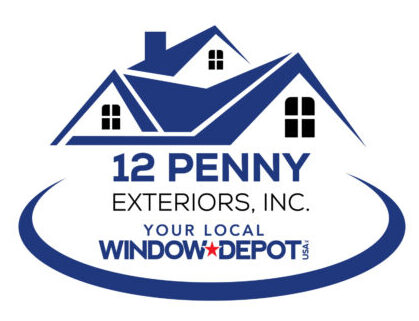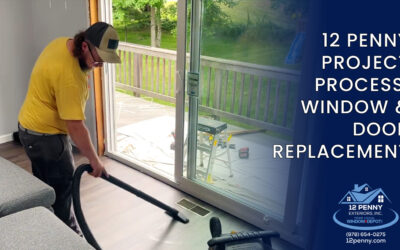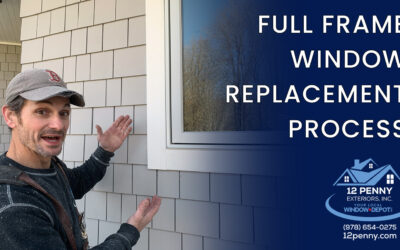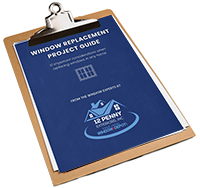If you are in the market for an entry door, or are just curious to learn more about them, you are in the right place. This guide will cover everything from styles and materials, to energy efficiency, construction, and installation. There can be a lot to consider when researching or shopping for an entry door, and we hope this guide will answer a lot of your questions. If you have a question not answered here, give us a call or send us an email; we’d be glad to answer it for you!
This guide focuses on residential homes and not commercial properties. Commercial applications can be very different and are not included in this article.
Entry doors: defined
When we talk about ‘entry doors,’ we are referring to any door that allows entry into your home and is not considered a “patio door.” Entry doors are typically the doors most often used to gain access to your home. Some entry doors are “side doors” or even a “basement door.”
(We will save patio doors (sliding, folding, French, etc.) for another guide.)
Table of Contents
Anatomy of a modern entry door
There are many different styles and types of doors on the market, and many advances have been made in door technology in the last several years. Today’s entry doors can be made from one of several materials, including wood, steel, fiberglass, aluminum, or a combination of these materials. Each material has its own advantages in terms of durability, aesthetics, and energy efficiency. When we refer to entry doors, we mean the whole unit: the door slab and the frame, which go together as one and are almost always sold together as one product.

Frame Construction
The structure of an entry door starts with its frame. And when we say “frame” we really mean the jamb. Jambs are typically made of wood, steel, or composite materials. The jamb provides structural support and serves as the skeleton for the door panel.
In the past, door frames were typically built entirely of wood. Wood, while being a strong and sturdy material, is also very good at wicking water, which means that over time, a door frame that gets wet due to weather can begin to absorb water, generally down at the bottom where water accumulates. Door jambs made entirely from wood still have this issue, and most often fail because of rot at the base of the door frame. Better-quality doors today are built with a section of the frame (right down at the bottom) made of a composite material that does not wick water. This ensures much more longevity for the life of the entire door unit.

Door Slab Construction
The part of the door that actually opens and closes is called the slab. Depending on the material used for the slabs of the door, the process and manufacturing techniques can vary. Most door slabs are made of either wood, fiberglass, or metal.
Wooden Doors
Traditional wooden doors are crafted by joining together solid pieces of wood or wood panels. Modern techniques may involve the use of engineered wood products such as plywood or MDF (Medium Density Fiberboard) for improved stability and resistance to warping. While wooden doors are not sold in abundance, they are still manufactured and can provide a beautiful look to any home.
Fiberglass Doors
Fiberglass doors are constructed by layering fiberglass sheets over a wooden or steel frame. The fiberglass can be molded to mimic the appearance of wood grain or other textures. Today’s fiberglass technology has greatly improved over the past 15 years or so, and it is considered one of the premium materials for obtaining almost any kind of look or finish.
Steel Doors
Steel doors are fabricated from sheets of steel, which are cut, shaped, and (usually) welded together to form the door panel. Insulation may be added between the steel layers for energy efficiency. Factors that can determine the quality of a steel door include the gauge (thickness) of the steel used, as well as what kind of insulation is used between the steel layers.
Energy efficiency
When it comes to entry doors, energy efficiency is often overlooked, but it is a very important factor to consider. While a typical window may take up approximately 13 square feet of space, a door can take up 35 square feet, and sometimes more. Fortunately, modern entry doors are designed and constructed with several features aimed at maximizing energy efficiency.
Insulation Materials
A high-quality insulation material such as polystyrene foam is injected or sandwiched between the layers of the door slab. This helps to reduce heat transfer through the door, improving thermal performance.
Energy-Efficient Glass
If the door includes glass panels, they are often constructed with energy-efficient glazing, such as double, triple, or even four panes of glass with argon or krypton gas inserted between the panes. This enhances insulation and reduces heat transfer through the glass. Some doors feature Low-E (low emissivity) coatings on the glass surfaces. These coatings reflect infrared heat energy, keeping the heat inside during winter and outside during summer, thus improving overall energy efficiency.
Weatherstripping and Seals
High-quality weatherstripping materials, such as compression seals or magnetic strips, are installed around the edges of the door to create a tight seal when closed. This helps prevent air infiltration and drafts, reducing energy loss.
Tight Installation
Proper installation is crucial for maximizing energy efficiency. The space between the door jamb and the rough opening must be properly sealed and insulated to minimize air leakage around the perimeter of the door.
ENERGY STAR Certification
Many modern entry doors are ENERGY STAR certified, meaning they meet stringent energy efficiency criteria set by the Environmental Protection Agency (EPA). Choosing an ENERGY STAR-certified door ensures that it has been independently tested and verified to meet or exceed energy efficiency standards. Just remember to check the ENERGY STAR qualifications for your part of the country. A door installed in Maine will require much different energy performance than a door installed in Arizona.
Storm doors
We are often asked “Do I need a storm door?” The best answer is ”it depends.” If you want to increase the energy efficiency of your door – much like storm windows meant to do on old, single pane windows – then the answer is no. Most entry doors will meet or exceed ENERGY STAR guidelines so adding another door will have marginal benefits.
However, if you want to leave your entry door open in the spring or summer to let fresh air inside through a screened storm door, then the answer is yes. Storm doors are also nice to have if Fido likes to look out at the squirrels.
A word of caution!
We have seen storm doors purchased with added Low-E coatings. While this may increase the efficiency of the storm door, it can wreak havoc on your entry door. With Low-E coatings, the heat build up between the storm and the entry door can cause paints and stains to fail and can cause fiberglass skins to peel off. Many door manufacturers will void their warranties if you install a storm door with a Low-E coating on it.
Entry Door Style
Modern replacement entry doors come in a wide range of styles to suit different architectural designs and aesthetic preferences.

Some of the most popular styles available today include:
Traditional/Classic
Classic styles often feature timeless designs with simple, clean lines. They may include panel configurations, raised or recessed panels, and traditional hardware finishes like brass or bronze.
Craftsman
Craftsman-style doors are characterized by their emphasis on natural materials, craftsmanship, and geometric patterns. They typically have square or rectangular panels, often with glass inserts featuring geometric patterns or leaded glass.
Contemporary/Modern
Contemporary and modern doors often showcase sleek, minimalist designs with clean lines and geometric shapes. They may feature large glass panels, asymmetrical designs, and unconventional materials such as aluminum or glass.
Rustic/Farmhouse
Rustic or farmhouse-style doors evoke a sense of warmth and coziness with their natural wood finishes, distressed textures, and decorative elements like wrought iron hardware or decorative hinges.
French/Double Doors
French doors, or double doors, consist of two hinged panels that swing open from the center. They are often used to create a grand entrance and allow for ample natural light to enter the home. French doors may feature glass panels or decorative grilles.
Arched/Radius Top
Arched or radius top doors feature a curved or arched top panel, adding architectural interest and elegance to the entryway. They may come in various styles, including traditional, contemporary, or rustic designs.
Glass Doors
Glass doors incorporate glass panels, either as inserts or as the primary material, to enhance natural light and provide visual interest. They come in various styles, including full-glass, half-glass, or decorative glass designs.
Custom Designs
Many manufacturers offer custom design options, allowing homeowners to personalize their entry doors according to their specific preferences, such as unique panel configurations, custom finishes, or decorative accents. Outswing doors, although not as common as a typical inswing door, are also available and can be a good choice if opening a door into the home causes spatial problems, like hitting a staircase or blocking an interior doorway.
Customization
There are countless ways a door can be customized to suit one’s personal preferences. Beyond selecting the material and overall style of a door, many other details can be customized:
Panel Configuration
Panel doors can feature different configurations of raised or recessed panels, such as single-panel, double-panel, or multi-panel designs. The number and arrangement of panels can be customized to create a unique look.
Glass Inserts
Glass inserts can be added to entry doors to enhance natural light and visual appeal. Homeowners can choose from various types of glass, including clear, frosted, tinted, decorative, or stained glass, as well as different shapes and patterns.
Hardware
Hardware options for entry doors include handles, locks, smart locks, hinges, door knockers, mail slots, peep holes and doorbells. Homeowners can choose from a wide range of styles, finishes, and materials to complement the overall design of the door.
Finish and Color
Homeowners can choose from a virtually unlimited palette of colors and finishes to match their home’s exterior or make a statement. Entry doors can be finished with paint, stain, or natural wood finishes to achieve the desired aesthetic appearance. Most door manufacturers will offer “smooth” doors, which are great for painting, or simulated wood-grains like oak, cherry, or mahogany. These doors can accept either paint or stain and give the look and feel of real wood.
Factory Applied Paint or Stain
Although you can paint or stain your entry door as a DIY project, we always recommend you get the paint or stain (even your custom color choice) applied at the factory. Most door manufacturers will have 10 or 15 year warranties on their finishes and your local painter will never be able to match the quality and finish that the factory can.
Custom Sizes
Entry doors can be custom-sized to fit non-standard openings or to create a specific design effect. Custom sizing ensures a precise fit and maximizes the visual impact of the door.
Decorative Accents
Decorative accents such as sidelights, transoms, grilles, moldings, and carvings can be added to entry doors to create a unique and inviting entranceway.
Security
Security features such as multipoint locking systems, reinforced frames, impact-resistant glass, and smart lock technology can be incorporated into entry doors to enhance home security and peace of mind.
Better quality doors are built to withstand forces well beyond ‘normal use’ cases. Some manufacturers engineer and test their entry doors to withstand high winds or forced entry. It’s important to remember that this added security comes not only from how the door is made but how it is installed. It is imperative that all entry doors be installed per manufacturer’s recommendations.
When does my door need replacing?
Entry doors may get a lot of use, especially if they are the primary entrance used in a home. These signs of damage, age, or energy inefficiency might indicate it’s time for a replacement:
Visible Damage
Visible signs of damage, such as cracks, dents, warping, or peeling paint can indicate a bigger problem. Significant damage may compromise the structural integrity and security of the door.
Difficulty Opening or Closing
If the door is difficult to open, close, or lock properly, it may indicate issues with the door frame, hinges, or hardware. This could be due to warping, misalignment, or wear and tear over time.
Drafts or Air Leaks
Drafts or air leaks around the edges of the door can be indications of poor insulation or damaged weatherstripping. This issue leads to unnecessary energy loss (read: money wasted) and decreased home comfort.
Water Damage
Signs of water damage include swollen or rotting wood, mold or mildew growth, or water stains on the door or surrounding walls. Water damage can compromise the structural integrity of the door and lead to further issues if not addressed.

Faded or Discolored Finish
Over time, the finish on the door may fade or become discolored due to exposure to sunlight and weather. This can detract from the curb appeal of the home and may indicate the need for refinishing or replacement.
Security Concerns
If the door lacks proper security features or if the locks, hinges, or strike plate are worn or damaged, it may pose a security risk. Upgrading to a more secure door with modern locking mechanisms can help enhance home security.
Energy Efficiency Issues
High energy bills or noticeable temperature fluctuations near the door may indicate poor energy efficiency. Upgrading to a more energy-efficient door with insulated cores, weatherstripping, and Low-E glass will help save money on energy bills (and reduce your carbon footprint).
Outdated Appearance
If a door looks outdated or does not complement the style of the home, replacing it with a newer, more aesthetically pleasing door can enhance the overall curb appeal and value of the property.
Noise Transmission
Doors that allow a significant amount of outside noise to enter the home may indicate poor sound insulation. Upgrading to a door with soundproofing features can help reduce noise transmission and create a quieter indoor environment.
Age of the Door
Finally, the age of the door itself can be a factor in determining whether it needs replacement. Older doors may be more prone to issues such as wear and tear, deterioration, and outdated design features.
How replacement doors are installed
Replacing an entry door involves several steps to ensure a proper fit, secure installation, and optimal performance.
Measurements
Accurate measurements of the door opening are essential to ensure the new door fits properly. Most door companies can custom-make their entry doors to fit your current opening. Width, height, and depth of the opening, as well as the thickness of the door frame, must all be measured accurately so that the door is made to fit properly.
Preparation
Before installing the new door, the old door and frame must be removed. Some companies will just remove the “slab” or panel of the door but at 12 Penny Exteriors, we replace the entire frame of the existing door as well. This guarantees we can see if any problems have developed behind the door jambs. Once we get the opening down to the rough framing, we have a much better idea of the integrity of the opening.
Installation of Door
Once the opening is properly prepped and flashed for the new door, the installation can begin. The key to a successful installation is making sure the door is square, level, and plumb in the opening. Also, proper shimming is required to safely secure the door into the opening. Manufacturers often have installation guidelines which must be followed to insure a great fit and to validate any warranties.
Sealing and Insulation
After installing the door, any gaps between the rough framing and door jambs should be properly insulated either with fiberglass insulation or, preferably, a low-expansion foam insulation. The outside of the door should also be sealed and caulked with a heavy duty silicone or hybrid type caulk. We do not recommend using latex caulk on the exterior, unless it has been tested to temperatures below freezing.
Installation of Hardware
Once the door is installed, door hardware such as locks, deadbolts, knobs, or kickplates, can be installed. Most manufacturers will either supply this hardware with the door or prep the door by drilling deadbolt and lockset holes at the factory. This type of prep is recommended as drilling these holes on-site can be tricky and could damage the exterior skins of the door itself.
Adjustments and Testing
After installation, the door should be tested to ensure it opens, closes, and locks smoothly. Adjustments may be needed to ensure proper alignment and operation. The door should also be checked for any gaps and to make sure all reveals are even.
Finishing Touches
Finally, any interior or exterior trim or molding around the door frame can be installed to cover gaps and provide a finished appearance. Touch-up painting or staining may also be needed to match the door to the surrounding surfaces.
Cleanup
Once the installation is complete, any debris or leftover materials should be removed from the work area, leaving the space clean and tidy.
Frequently Asked Questions about door installation
Do I need a permit to install a door?
The short answer is yes – you should obtain a building permit when replacing an entry door. There are a couple of reasons why you should. If any re-framing needs to be done due to rot found along the way, or if you are making an opening bigger, for example, the inspector will most likely want to inspect this work before the door is installed. In Massachusetts, the inspector is also going to want to make sure the door meets or exceeds the Massachusetts Energy Code.
It is always a good idea to check with your local building department and codes before beginning any significant work on your house. If you choose to work without a permit and get caught, they could require you to stop the work and the fines can be hefty.
How long does it take to replace an entry door?
Most entry doors will only take about a day to install. If you have a door with sidelights and a transom, and you have also decided to add a storm door, then it could take a couple of days. Very rarely does an installation take longer than 1-2 days (unless unexpected damage is found in the framing around the doorway when the old door is taken out).
{video or gif of timelapse door install?}
Range of Costs for Entry doors
Many factors will affect the cost of a new door, most notably the type and quality of the door, customizations chosen, and regional location. Given the wide range of products on the market, the range of costs is wide as well. Homeowners in New England, for example, can expect to spend anywhere between $3,500 and $25,000 (or more) depending on the entry door system needing replacement.
In addition to this range, here are some helpful tips to keep in mind:
- Because of the regional variability in installation costs, online resources that quote a ‘national average’ are usually not very accurate when it comes to the actual cost of an entry door system in your area.
- When you see online prices at big box retailers, that price doesn’t give you a complete picture. It doesn’t take into account any customizations your door may need. Also keep in mind installation may not be included in the price you see.
- Don’t forget to take into account all of the factors that go into having a door replaced, beyond the cost of the door itself: removal and disposal of the old door, interior and exterior trim, installation of the new door, and hardware.
We can usually give you a pretty accurate estimate just by looking at some photos of your old door and asking you some questions about what you are expecting for a new door. Our phone consultation estimates are always free and are a great way to see if a new entry door is within your budget.
What’s the difference between something from a big box store vs a custom-made product?
This is a question that many people may consider when looking at the big price difference between something you can buy ‘off the shelf’ at a big box retailer vs. something custom manufactured. There are a number of factors to consider:
Materials and Quality
Custom-manufactured doors often use high-quality materials chosen specifically for the customer’s preferences and needs. This may include premium woods, durable metals, or advanced composite materials. The construction and craftsmanship of a custom-manufactured door are typically of higher quality and meet the customer’s specifications exactly.
Doors sold at big box stores may vary in quality depending on the brand and model. While some may offer decent quality, others may use lower-grade materials and construction methods to keep costs down. The range of materials and quality may be limited compared to custom-manufactured options.
Design Options and Customization
Custom doors offer virtually unlimited design options and customization opportunities. Customers can choose from a wide range of styles, sizes, materials, finishes, glass options, hardware, and decorative elements to create a unique door that matches their vision and complements their home’s architecture.
On the other hand, doors at big box stores typically offer a more limited selection of designs, sizes, and customization options. While there may be some variety in styles and finishes, the choices may not be as extensive or tailored to individual preferences compared to custom-manufactured doors.
Fit and Compatibility
Custom doors are made to fit the specific dimensions and requirements of the customer’s entryway. This ensures a precise fit and seamless integration with the existing architecture and framing, minimizing the need for modifications during installation.
Doors purchased from big box stores are often available in standard sizes and configurations, which may not always match the dimensions of the customer’s entryway perfectly. In some cases, modifications may be necessary to ensure proper fit and compatibility during installation.
Price
Custom-manufactured doors tend to be more expensive than doors purchased from big box stores due to the higher quality materials, craftsmanship, and customization options.
Doors sold at big box stores are often more affordable due to economies of scale, standardization, and mass production. However, there may be additional costs for customization, installation, and warranty services.
Installation and Warranty
Generally working with an experienced door installer is the best way to acquire a custom door. Proper installation is a crucial key to the success of even the best custom-made door, and is required to validate any warranties or guarantees on their products that are offered.
While some big box stores offer installation services for doors purchased from their stores, the quality and reliability of these services may vary. Customers may need to hire their own contractors for installation, and warranty coverage may depend on the specific terms and conditions provided by the manufacturer or retailer.
Choosing an Installer
There are many different paths you can go down to get a new entry door installed in your home. You could go to a big box store or lumber yard and pick out a door. Oftentimes, these places will offer installation services as well. Unfortunately, they will depend on the homeowner for accurate measurements and will often release themselves of liability if the measurements are not correct.
Another option is to call a local handyman or general contractor. While they may be familiar with installing a door, they are often limited to the door brand their local supplier carries and are not familiar with other manufacturers. Most handymen or general contractors will not sit with you to help design a door to your exact specifications.
At 12 Penny Exteriors, we know doors. We have experience with many different door manufacturers and can help you understand the pros and cons of any product before you buy. We can also help you design the door and can virtually superimpose it on your house so you can visualize what it will look like on your home. Our expertise continues beyond choosing the best door for your home; we are expert door installers with extensive experience installing all kinds of doors in all kinds of homes.
You’ve made it to the end of our entry door guide! If this information has left you wanting more, you can find it here.










